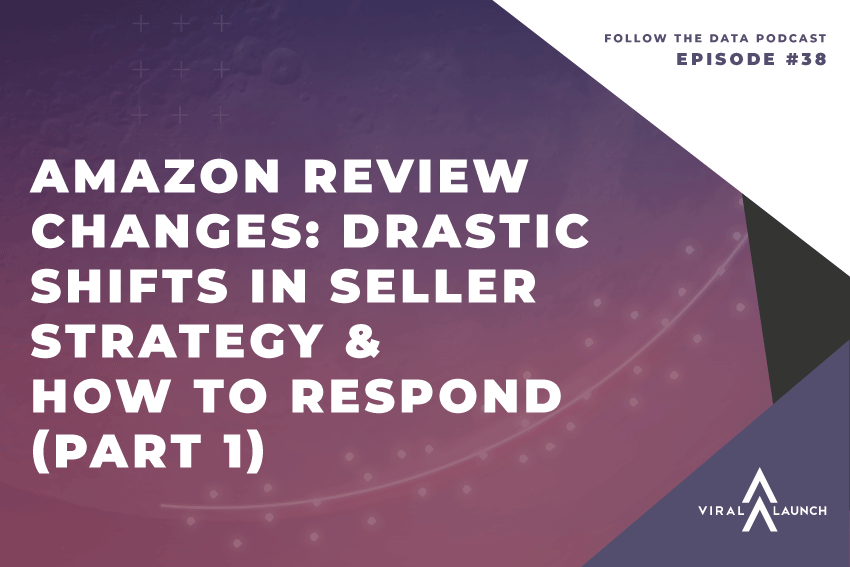Amazon Review Changes: Drastic Shifts In Seller Strategy & How To Respond (Part 1)
As a Seller, it’s a serious challenge to grow your business and increase sales while so many changes are constantly happening to Amazon’s platform. Amazon is changing the way that buyers ‘buy’, and sellers ‘sell’. Over the past month, Amazon has been making changes to Reviews. Some of these changes have already drastically altered Seller Strategy. Other changes have the potential to drastically alter Seller Strategy in the future. In this episode, we break down recent changes to reviews on Amazon. We’ll break down what the data is saying, how these changes impact you now, and how they impact your future on Amazon.
Listen on iTunes Listen on Stitcher
Podcast Transcript
CAMERON YODER:
As a seller it’s a serious challenge to grow your business and increase sales while so many changes are constantly happening to Amazon’s platform. Amazon is changing the way that buyers buy and sellers sell. And too often Amazon will make changes without any sort of warning or indication of what’s to come.
CASEY GAUSS:
Over the past month Amazon has been making changes to reviews. Some of these changes have already drastically altered sellers’ strategy. Other changes have potential to drastically alter sellers’ strategy in the near future. I’m Casey Gauss.
CAMERON YODER:
And I’m Cameron Yoder, your hosts for Follow the Data: Your Journey to Amazon FBA Success. In this show we leverage the data we’ve accumulated at Viral Launch from over 30,000 product launches and our experience working with more than 8,000 brands to help you understand the big picture when it comes to Amazon and the best practices for success as an Amazon seller.
CASEY GAUSS:
In this episode Cam and I are going to break down recent changes to reviews on Amazon. We’ll break down what the data is saying, how these changes impact you now, and how they may impact you in your future Amazon endeavors. Let’s jump in.
CAMERON YODER:
All right, so we’re talking about the review apocalypse –
CASEY GAUSS:
Apocalypse?
CAMERON YODER:
– that’s happening. No.
CASEY GAUSS:
Review apocalypse.
CAMERON YODER:
Review eclipse.
CASEY GAUSS:
All right, review apocalypse it is.
CAMERON YODER:
All right, it’s settled.
CASEY GAUSS:
Anyways, so guys there’s five major changes that we want to go through. Candidly, we don’t have all the data, nor do we want to act like we do. So we want to show you what we’re seeing. You know, we’re tracking hundreds of millions of products on Amazon, so we want to use this data to help you make better decisions, to really get a good scope or understanding of the scope of the changes that are being made. And so this is something, probably a topic that we’ll have kind of an updated post on, whether it be a blog post or podcast, so that you can see like how those changes are continuing throughout Amazon or as we continue to get more data.
CAMERON YODER:
And some of this episode really is just updating you on what has happened in the Amazon space, and another aspect is, like Casey said, delivering actual data and information. And also, like Casey said, we’re still accumulating data on this subject, and so that’s why we don’t necessarily want to point to very specific numbers, acting like we have it all conglomerated right now because we’re still collecting that data. But again, telling you what’s happened, collecting all that information while also delivering you some information that we do have.
CASEY GAUSS:
Right, and at the end of the day I think there’s two main things that you need to walk away with – well, three main things. One, just a better general understanding, but two, I mean more and more are changes happening faster and faster on Amazon, and so I think that you absolutely need to just get used to it. So it is the sellers that are quickest to adapt to whatever changes are being thrown their way, whether it be from competitors, suppliers, or from Amazon themselves. Those that are willing and able to adapt to whatever the new landscape or new paradigm looks like are those that are typically the most successful. So we want to help you get the knowledge you need to know what decisions to make moving forward. And then number three is just that so many people freak out about some of these changes, and like I said these are going to be happening more and more. I imagine so.
And so just understand that when these changes are made these are opportunities for you to adapt, move quickly, and at the end of the day, you know, a lot of the times it just levels the playing field even more. So we look at it as – or you may look at it as, you know, this change is now going to have this dramatic impact on your business. Oh wow, how can we continue? But in reality a lot of the time it just levels the playing field for those doing black hat activities and allows you to have that much more of a competitive advantage or to diminish the competitive advantage those black hat sellers do have. So it’s not always the case, but for the most part it is, and so I just want to encourage you to be okay with these changes. And don’t freak out. Just adapt with them. Figure out the new rules, play to those new rules so that you can continue to kill it on Amazon.
CAMERON YODER:
Adapt, learn, and let’s talk about those five changes, five major changes that are, or have already happened, or are currently happening, or are going to happen in the future. The first one, the first one that we want to talk about are random reviews that are being completely – I shouldn’t even say maybe random necessarily.
CASEY GAUSS:
Seemingly.
CAMERON YODER:
But seemingly random or selective reviews that are being wiped off of Amazon. Casey, what we got here?
CASEY GAUSS:
Yeah, so we are still compiling the stats. We’ll probably have a blog post out at the time of releasing this. We’re crunching a lot of information right now. It’s a little bit tough because there’s multiple changes happening at the same time, and we’re trying to silo those changes. But anyways, literally millions of reviews have been wiped from Amazon over the last 60 days. So over the last 90 days there have definitely been changes. The majority of changes actually have come over the last 30 days at the time of recording this. This is June 5th. So over the last 30 days, but a good amount over the last 60, even more over the last 90, but literally millions of reviews are being wiped. And so, so far the product that we’ve seen the largest drop in review quantity is actually 16,000 reviews lost on one ASIN.
CAMERON YODER:
Single product. That’s a single ASIN. That’s not necessarily variations. Or does that include variations or not?
CASEY GAUSS:
Does not include variations.
CAMERON YODER:
Single ASIN.
CASEY GAUSS:
A single ASIN lost 16,000 reviews. Now you know, there’s just these wild review fluctuations going on, so I’ve seen everything from – I was looking at a product where it lost 11,000 reviews in a day and went down to like one, two reviews or something like that. But literally like a few days later got like half – so I’ve seen some products where they get all their reviews back, and then I’ve seen some products where they get like half their reviews back, right? And so it’s literally all over the place.
CAMERON YODER:
So Amazon, have we – there isn’t necessarily a pattern, correct, that’s been recognized as to these reviews being removed and/or are they correlated with something like black hat activity obtaining those reviews?
CASEY GAUSS:
Yeah, I mean there’s got to be a method behind the madness, and that has not seemed very apparent to us. So this is happening for brands like Rubbermaid, and TP-Link, and Netgear. So these major, major brands, but also happening to third-party sellers. And it can be as little as a couple of reviews being removed. Sellers may not have even noticed. But then, like we said, some people losing over 10,000 reviews on a single product.
So it’s across the board. So one theory that we have, kind of from some of our tests – now I want to stipulate that this is a theory. This is not proven. We don’t have insider data helping us to understand this. But what we are seeing is that Amazon is flagging particular buyer accounts. And so this lines up with another change that we’re seeing. And so which, you know, it helps to support this theory. But essentially we feel as though, or we think that we’re seeing individual buyer accounts get flagged. And what’s this this means is essentially – and this spreads into another point coming up – but anyways, if a particular buyer account gets flagged for leaving suspicious reviews or whatever, we then see either all of that person’s reviews removed, so you know that would affect all the products that they’ve purchased and left reviews on. So it’s not specifically targeting a single ASIN, and those ASINs may – we’ll bring it up in another point, but something else will happen to those ASINs.
But so I do know that they – or very much so believe that they are targeting individual products as well. That’s why there’s no chance that they are targeting, let’s say this product that lost 16,000 reviews, on one day they didn’t find 16,000 buyer accounts or whatever that had happened to leave a review on that product and wiped all of them out. They’re going after individual products as well.
CAMERON YODER:
Yes, so impact on the market – basically, again, point number one is that reviews seemingly are being removed. Whether it’s completely random or specified to a specific product, it’s unclear at this point in time. But regardless, reviews, a large amount of reviews, have been removed and are currently being removed.
CASEY GAUSS:
So one interesting thing here – so again, the question is how much time do we want to take to really go and quantify some of these things because we have the data; it’s just a matter of opportunity [cost 0:08:49.1]. We’re working on some big things, but so I was just doing some quick looking around last night and some products that had 5,000 reviews removed or whatever, like some of them you can see on the exact day that those reviews were removed you can see a drop in their sales or a drop in their best seller rank.
CAMERON YODER:
Crazy.
CASEY GAUSS:
Right. And so you can easily see that this is definitely, definitely having an impact on sellers. Now we didn’t go – you know, we could do some really cool things like go and quantify the average impact to sales that is being had on the products that are losing reviews, and we could see like if they lost at least X percent of their reviews it had this kind of impact on sales. Interesting stats, for sure, but maybe not worth our time. You know, if you’re listening and you really, really, really want these stats and you’re going to promise to share and tell all your friends, like shoot us an email, and if we get enough feedback like maybe we will really go dive in because it’s definitely interesting. We just have so much that we’re working on. It’s hard to –
CAMERON YODER:
Right. All that to say what we are seeing is a direct correlation between these reviews being removed and a drop in sales. So there is significant impact being placed on the market right now.
CASEY GAUSS:
And one of my favorite points about this is like there is that study, and there’s a bunch of, you know, software providers in the space [unintelligible 0:10:13.2] saying that if you have over 21 reviews then there is no difference, right? And so these guys who are losing – this person that lost 16,000 reviews, they still have hundreds of reviews, and some of them that lost like 5,000 reviews or whatever, they still have thousands of reviews, but they did still see a decline in sales because they lost reviews even though they have over 5,000. So if more than 21 reviews, or more than 1,000 reviews, it doesn’t matter, and it doesn’t affect sales? That’s absolutely not true, and this is the best example of that.
CAMERON YODER:
So point number one, reviews are being wiped. Point number two – this is an interesting one – reviews are getting split, seem to be getting split, among variations. Now here’s the thing. About some of these points that we’re talking about, we’re not saying that they are indefinitely going to happen across the entire Amazon platform. However, what we are recognizing is that they are happening with specific ASINs. So in this case what we are seeing is that how things used to be, basically, all products would share reviews under the parent ASIN. So let’s say you have a – you’re selling a coffee mug. Let’s say you have a red coffee mug and you have a blue coffee mug. If you go to that parent ASIN that has all the variations you would see the same amount of reviews. They would just be – all the variations would share those reviews. Now what we’re seeing with a couple products on Amazon is that the people that bought a red coffee mug and leave a review, the review sticks for that red coffee mug specifically. And then people that buy the blue coffee mug and leave a review, those reviews are left for the blue coffee mug specifically. So what ends up happening is if you’re looking at variations under a parent ASIN, each variation is going to have a different number of reviews and just different reviews in general.
CASEY GAUSS:
Yeah, so actually, Cam, I’m pretty confident that this is going to be happening across the board –
CAMERON YODER:
Everywhere.
CASEY GAUSS:
Yeah, Everywhere.
CAMERON YODER:
But not right now. Right now it’s not across the board.
CASEY GAUSS:
Right now it’s not, but something definitely to expect. So this, I feel like does kind of suck. But I see some benefit to it as well. So it does suck from the standpoint of one very common strategy is to just put everything under one listing so that you can take advantage of the reviews, start getting some sales going on a new ASIN, and then once you have a significant number of reviews on that new ASIN, you can then split it up, then go take as much of the search result real estate as possible. So this strategy is going to be gone now, I think, unless the majority of searches are coming for like blue coffee mug but people end up buying the red coffee mug or something like that. But I think the main advantage of this, of these variation hacks are gone.
So we’ll see what happens. I think that as we all have to kind of adapt to this new system or whatever, this new structure, we will continue to develop new strategies as we think about it. You know, I haven’t really taken much time to think about it, but definitely something to be aware of. I have some friends who were absolutely killing it because one of their variations was just like had tons and tons of reviews, but when they were ranking for other keywords they still showed those reviews, and so they were just able to wipe everybody out in their market. And now they won’t have that advantage. Now sure, because they leverage that they got more sales, which allowed them to generate more reviews. So they are much better off than had they not have done that in the first place, but still can definitely be impactful for people.
CAMERON YODER:
This change of each variation having their own unique number of reviews does really benefit the consumer. It is very beneficial for a customer to go in, look at variations and see reviews for those specific products. For sellers specifically it does make things a little bit more difficult. But again, like Casey said towards the beginning, this is just something that as a seller you’re going to have to adapt to because it does make sense. It just makes everything a little bit harder.
CASEY GAUSS:
So one down side to this, I was hoping that it would – maybe some of you guys have seen the examples where, you know, it’s a testosterone cream that has 10,000 reviews and all the reviews are for like crazy things like cat beds, HDMI cables, like camping gear, stuff like that. The reviews are for these really random, random products for a testosterone cream. And so I was hoping that this update would make that tactic not available because it sucks. If somebody can just go and get 10,000 reviews out of nowhere and they’re all verified, like that sucks. And so you know they don’t always remain, and Amazon will wipe them out sometimes, not all the time. But regardless, that tactic still remains as a black hat tactic that people can use against you unfortunately. Hopefully that is something that is blocked here soon. I can’t imagine that it’s not. We’re actually talking about just for fun so that everybody knows and maybe to help bring it to Amazon’s attention, building just a quick tool that helps us to find those reviews – or sorry, those products that are cheating in this manner or using this method because like at the end of the day like I appreciate people’s hustle and like, you know, their ingenuity for coming up with these things, but it hurts the seller that’s trying to be legitimate.
CAMERON YODER:
It does.
CASEY GAUSS:
And as a company we have to play by the rules, and we have to teach people to kind of play by the rules.
CAMERON YODER:
Overall I think this change makes sense for some very specific variations on products in Amazon, like if they’re very different, like if you’re talking about variations with jewelry where you have a ring that has a completely different diamond design than another, that makes complete sense. But for others where it’s just kind of a simple color variation, I think that’s a little more difficult. Bottom line, this kind of make sellers have to work a bit more or work a bit harder for reviews in general. Like if you have five variations, now you’re going to have to maybe work five times as hard to get those reviews for each variation. In the end, though, this is an adjustment that you as a seller are going to have to make, and so that is point number two. Point number two is reviews that are being split among variations. Another review change, another thing involving reviews that has changed in the market –
CASEY GAUSS:
It has been deemed the quote Great Amazon Purge.
CAMERON YODER:
The Great Amazon Purge. And I believe the stat – Casey, correct me if I’m wrong, but I believe the stat is 4,800 out of the top 10,000 reviewer accounts were wiped out completely.
CASEY GAUSS:
Yeah.
CAMERON YODER:
Completely.
CASEY GAUSS:
So according to reddit – we’ll post it in the show notes – you can go see they have this bot that is going and finding new Amazon top reviewer accounts that have been purged. And so 4,800, you know that’s half of the Amazon top reviewers, which is just – so there’s 10,000 – maybe there are still 10,000?
CAMERON YODER:
Well, maybe there are still 10,000, but –
CASEY GAUSS:
Yeah, of the top 10,000 Amazon reviewers 5,000 of them have been shut down. And I think this shows that nobody is safe. They’ve always kind of drawn attention to these top reviewers and hailed them as like, you know, their reviews really mean a lot. And apparently they don’t mean too much if Amazon is willing to get rid of half of them.
CAMERON YODER:
If they’re removing them.
CASEY GAUSS:
Yeah, so anyways, not like super actionable, but definitely interesting.
CAMERON YODER:
It’s just that does show that no one is safe, and perhaps, again, like we saw before where some reviews were allowed to kind of come back into the system, perhaps Amazon has taken these reviewers out of the system and will let them come back. But for now they’re gone.
CASEY GAUSS:
I don’t know about them coming back because if you have seen any of the articles recently for the last month or two of buyer accounts that get banned from Amazon because of like too many returns or stuff like that, and then that person just is not able to create a new account or use their Amazon account anymore, which is really crazy to see.
CAMERON YODER:
It is. Fourth change, fourth change involving reviews.
CASEY GAUSS:
This is probably the most minor so far but could be a precursor to other new things.
CAMERON YODER:
It’s an indication of something that we’ve actually talked about before in a review episode a little while back.
CASEY GAUSS:
Yeah, if you haven’t checked it out – so we have some interesting and novel thoughts. Now I have heard some new people or some people talking about these ideas since our podcast, of course, but you should definitely check it out. Basically we talk about what we think Amazon’s review system will look like in the near- to mid-future. We think there has to be some systemic changes that will change a lot of the strategies and game on Amazon. So definitely check that out.
CAMERON YODER:
This fourth change kind of –, again the indication of this fourth change goes along with one of our big predictions which we had in that episode, but this fourth change involves seller feedback, okay? So before if you would go on to an offer listing page for products and you would look at all the different sellers with offers for that product you would be able to look at the seller feedback from the offer listing page, okay? So on the page you would look at all the offers, all the different offers from all the different sellers for that product, and from there you would be able to see seller feedback, the seller feedback rating. So typically, until very recently you were able to see, or Amazon displayed the lifetime, the total lifetime seller feedback that all of these sellers had. However, very recently Amazon has changed this display. So now instead of seeing seller feedback that is lifetime, that is that seller’s lifetime, it’s now displayed as a 12-month rolling feedback. So basically, long story short, instead of seeing lifetime feedback for a seller, now we’re starting to see that seller – Amazon is only displaying a 12-month rolling feedback.
CASEY GAUSS:
So yeah, 12-month rolling feedback is not a new thing, right? So if you go to a seller’s store then you will be able to see 30, 90 and –
CAMERON YODER:
Lifetime.
CASEY GAUSS:
12-month and lifetime feedback on the seller. And so they’ve been doing these rolling metrics, but this is the first time that we’re seeing it on the product page.
CAMERON YODER:
Right.
CASEY GAUSS:
Like and this is only happening to – it’s happening on the account level, which is very interesting. So again, we – just some quick glances weren’t able to discern what the cause or how they were delineating between who to show the aggregate or lifetime feedback versus the 12-month feedback, but this could definitely be a precursor to what we think is going to one of the ideas of how we think the Amazon review change is going to happen. So not very actionable, not too much going on, but definitely something interesting and to be paying attention to, especially just among all this noise among of review changes.
CAMERON YODER:
So instead of applying this to the product review side, this is an indication that in the future or sometime maybe Amazon will implement this rolling review system to products. So instead of seeing the lifetime reviews for a product, for example, maybe you’ll see the number of reviews that this product has gained over the past 12 months, at least displayed. And maybe if you click into that you’ll be able to see the lifetime reviews, but just like seller feedback, buyers often are not going to click on a seller, look at all their data and see the lifetime reviews. They’re just going to take what they see up front on the listing, on the offer listing page and say like okay, this seller has this review rating.
So again, indication possibly for the future. Maybe Amazon will push this rollover system into their product feedback into their product reviews. Point number five, the fifth review change that we see happening in the Amazon system right now are reviewers getting blocked, ASINs getting flagged. Casey, you touched on this a little bit at the beginning. Maybe touch on it specifically again.
CASEY GAUSS:
Yeah, so I’m sure some of you have seen it in the Facebook groups. We’ve been seeing this probably for the last three or four weeks, actually beginning of May. So over a month now, wow. So anyways, what happens is you go to leave a review and – on a particular product – you click on the star rating, and then it says – you know, a message pops up saying sorry, we’re unable to expect accept your review of this product. This product is currently – this product currently has limitations on submitting reviews. This may be because we deleted – or sorry – detected unusual review behavior on this product or to maintain the best possible shopping experience. And so then it has a link to the customer review guidelines. So there’s some really interesting things here. We have some more testing to do to figure out the specifics. We don’t want to disclose too much of what we’re doing to test, but basically this is very interesting.
And so what happens, or what we’re seeing happen is if there is a significant – now significant, we don’t know what that means exactly. If there is a significant number of reviews being left over a set period of time – we don’t know exactly what that set period of time is. We have some guesses. I’ll share that in a second. But if too many reviews are left over a certain period of time Amazon will block the reviews. And from what we’re being told this then triggers a – basically the product and/or brand has to be looked into further to better understand is this manipulative behavior, and if so, then go do deeper digging, where we’re seeing some people get suspended because their email sequence or whatever was not in line with Amazon’s guidelines. So they’re going – I think this is a manual process where they go, they review the product, they review the brand to go see what are these guys doing to see this kind of review volume? Is this malicious or not? And so we’ve seen where it takes as few as a few days to be unblocked from reviews. The most I’ve seen is seven consecutive days, but we have seen it go from seven consecutive days getting unblocked and then going through this dance of being unblocked and blocked. So one very interesting point here is that actually the unverified and verified reviews are blocked irrespectively.
So we haven’t tested too much of going back and forth, but so basically what we’ve tested is okay, a product is ineligible or currently being blocked for unverified reviews. Well, verified reviews, meaning someone has actually purchased a product at call it full price, is then still able to go and leave a review. But if too many verified reviews are left within – for us we’ve just been testing within the context of a day – if too many verified reviews are left within the context of a day, then the verified reviews will be blocked. And it’s possible that the verified reviews are blocked but not unverified reviews. So very, very interesting.
So what do we think kind of the limitations are? So just some casual testing here and there, it looks somewhere around three unverified reviews in a day and five to seven verified reviews in a day. So please don’t hold us to those numbers. We still have quite a bit more testing to do to find the specifics, but that gives you a general jumping off point. And so again, we mentioned that reviews could be, at the very beginning of this podcast, that we are seeing some products that seem to get blocked when some of the reviewers get flagged for – so if a reviewer gets flagged, then it is very possible that the products that they’ve left reviews on then get this review block, and this review block, like I said, can happen for days at a time. We’ve seen it where it’s blocked for three days, unblocked for a day, blocked for three days. And we’ve seen where a product is blocked but then is good for the last, I don’t know, three weeks or so. So still figuring out the specifics, but I actually, for the most part I like this.
So too often – we’ve all heard of the stories where products get hundreds of reviews over the course of a week or two weeks, and we all know that for the most part these are not legitimate methods, and there is one method that I know where you can get hundreds of reviews legitimately in the course of a week or so. But these are very rare and tend to be across a whole product line, not just a single ASIN. Anyways, I like this change because I feel like this is Amazon stepping up their game to make sure that these malicious black hat sellers are not getting tons and tons of reviews in a short period of time, able to just launch their product to the top and just start taking all of the sales on these products that don’t deserve it, essentially.
So we’ll see how this continues to change. One thing that I would love for Amazon to really start paying attention to, for a little bit we thought this was the case, but now not so sure about that, or not – I don’t think it’s in place right now, but I’d love for Amazon to kind of just pay attention to the referral path or where that customer is coming from to leave reviews. But anyways, I think they’re doing a good job of playing it safe so that we can take legitimate action. Now that does mean we have some – I have some friends that have legitimate review acquisition strategies where they’re getting like insane rates, like 20% review rate, which is just insane. The downside is they’re getting flagged, and so they are legitimate reviews from legitimate people and like legitimate buyers, and yeah, their ASINs are getting flagged because they’re doing too well with the review acquisition strategy. But overall I think that this is positive for people. Now it’s just a matter of figuring out what are the limitations in terms of too many reviews too fast so that we can stay within those lines and make sure not to get on Amazon’s radar, and to make sure that we are able to get as many reviews as quickly as possible in a legitimate fashion.
CAMERON YODER:
Overall, big picture, these five changes – I’m going to go over them again. The five changes, which were random reviews being wiped, reviews being wiped in general, reviews getting split among variations, the Great Amazon Purge, a.k.a. the top reviewers, 4,800 top 4,800 reviewers being wiped from Amazon, the seller feedback change into a 12-month rollover and blocked ASINs or blocked reviews being in place. Each of these seem to show Amazon’s moves now, which may indicate where they’re going in the future. Seemingly, Amazon is taking big steps, big strides that they haven’t really taken before against fake reviews, against reviews in general, making it, in some cases harder for small sellers, but also harder for big sellers. Basically they’re changing the way that reviews happen and are displayed on Amazon. And we could look at this, and we could say – we can look at this and just kind of moan the whole time that it’s happening and not act, but basically we have to play with the cards that we’re dealt, and in this case we have to play by the rules of the Amazon game. And the rules are changing a little bit right now.
CASEY GAUSS:
Yep. Overall I feel like this helps small sellers, these changes, outside of maybe the variation change.
KEN CHRISTIANSEN:
Right.
CASEY GAUSS:
But I mean it is what it is, and guys, we need to focus on how we can move forward and build the best business possible with the new rules versus looking at how things used to be and getting upset, complaining, or feeling like our chances of success are limited. They’re just – they are not. There is still so much opportunity for success. And yeah, let’s go and achieve these like crazy goals, build our dreams, chase after our dreams together, no matter what the specifics of the landscape are.
CAMERON YODER:
We want to thank you all so much for listening. Seriously, we do this for you, and we do this every week for you guys. We love hearing feedback from you. So if you have any feedback on today’s episode we honestly would love to hear from you on your thoughts on potential changes and the changes that are happening now for reviews on Amazon. So if you’d like to leave us any feedback at all, I’m going to encourage you, push you to our Facebook page. Seriously, if you go to – if you look up Viral Launch on Facebook and you just shoot us a message about the podcast we’ll get right back to you. That’s something you can do on your phone right now. Seriously, take out your phone if you’re listening and you’re not driving and shoot us a message right now. You can also look forward to our blog post on this subject. That will be going out sometime soon. And if you would rather call in, you can call us at 317-721-6590. But again, thank you all so much for listening. We look forward to your feedback and your questions. Until next time, remember, the data is out there.








